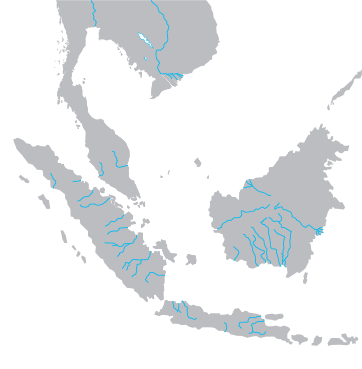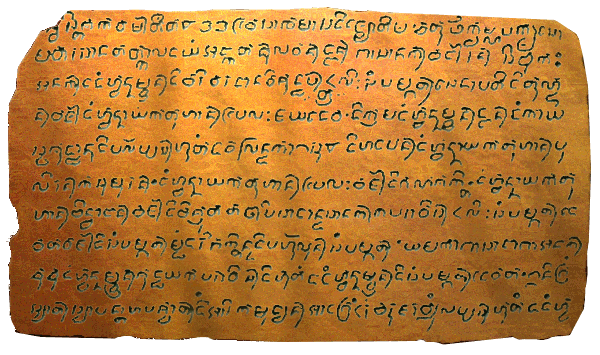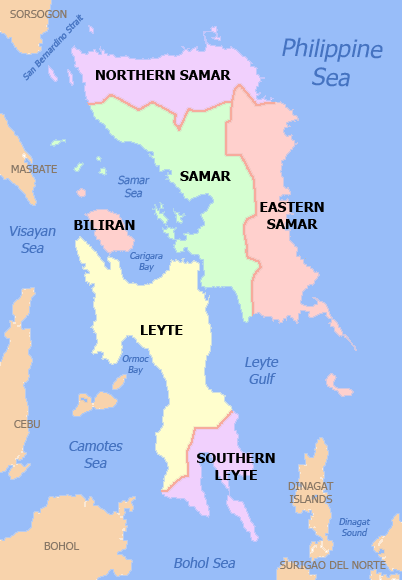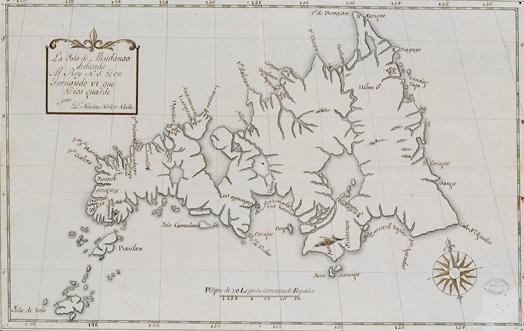|
Archaic Tagalog
Old Tagalog (; Baybayin: pre-virama: , post-virama rus kudlit ; post-virama amudpod ᜎᜓᜋᜅ᜕ ᜆᜄᜎᜓᜄ᜕), also known as Old Filipino, is the earliest form of the Tagalog language during the Classical period. It is the primary language of pre-colonial Tondo, Namayan and Maynila. The language originated from the Proto-Philippine language and evolved to Classical Tagalog, which was the basis for Modern Tagalog. Old Tagalog uses the Tagalog script or Baybayin, one of the scripts indigenous to the Philippines. Etymology The word ''Tagalog'' is derived from the endonym or (''taga-ilog'', "river dweller"), composed of (''tagá-'', "native of" or "from") and or (''ilog'', "river"). Very little is known about the ancient history of the language; linguists such as David Zorc and Robert Blust speculate that the Tagalogs and other Central Philippine ethno-linguistic groups had originated in Northeastern Mindanao or the Eastern Visayas. History Old Tagalog is o ... [...More Info...] [...Related Items...] OR: [Wikipedia] [Google] [Baidu] |
Philippines
The Philippines, officially the Republic of the Philippines, is an Archipelagic state, archipelagic country in Southeast Asia. Located in the western Pacific Ocean, it consists of List of islands of the Philippines, 7,641 islands, with a total area of roughly 300,000 square kilometers, which are broadly categorized in Island groups of the Philippines, three main geographical divisions from north to south: Luzon, Visayas, and Mindanao. With a population of over 110 million, it is the world's List of countries and dependencies by population, twelfth-most-populous country. The Philippines is bounded by the South China Sea to the west, the Philippine Sea to the east, and the Celebes Sea to the south. It shares maritime borders with Taiwan to the north, Japan to the northeast, Palau to the east and southeast, Indonesia to the south, Malaysia to the southwest, Vietnam to the west, and China to the northwest. It has Ethnic groups in the Philippines, diverse ethnicities and Culture o ... [...More Info...] [...Related Items...] OR: [Wikipedia] [Google] [Baidu] |
Proto-Philippine Language
The Proto-Philippine language is a reconstructed ancestral proto-language of the Philippine languages, a proposed subgroup of the Austronesian languages which includes all languages within the Philippines (except for the Sama–Bajaw languages) as well as those within the northern portions of Sulawesi in Indonesia.Llamzon, Teodoro A "Proto-Philippine Phonology."In: ''Archipel'', volume 9, 1975. pp. 29-42.Zorc, R.D. (1986). "The genetic relationships of Philippine languages." In Geraghty, P., Carrington, L. and Wurm, S.A. editors, ''FOCAL II: Papers from the Fourth International Conference on Austronesian Linguistics''. C-94:147-173. Pacific Linguistics, The Australian National University, 1986. Proto-Philippine is not directly attested to in any written work, but linguistic reconstruction by the comparative method has found regular similarities among languages that cannot be explained by coincidence or word-borrowing. Classification There have been three initial proposals in de ... [...More Info...] [...Related Items...] OR: [Wikipedia] [Google] [Baidu] |
Malay Language
Malay ( , ; , Jawi alphabet, Jawi: ) is an Austronesian languages, Austronesian language spoken primarily by Malays (ethnic group), Malays in several islands of Maritime Southeast Asia and the Malay Peninsula on the mainland Asia. The language is an official language of Brunei, Malaysia, and Singapore. Indonesian language, Indonesian, a standardized variety of Malay, is the official language of Indonesia and one of the working languages of East Timor. Malay is also spoken as a regional language of Malays (ethnic group), ethnic Malays in Indonesia and the Thai Malays, southern part of Thailand. Altogether, it is spoken by 60 million people across Maritime Southeast Asia. The language is pluricentric and a ISO 639 macrolanguage, macrolanguage, i.e., a group of Mutual intelligibility, mutually intelligible speech varieties, or dialect continuum, that have no traditional name in common, and which may be considered distinct languages by their speakers. Several varieties of it ar ... [...More Info...] [...Related Items...] OR: [Wikipedia] [Google] [Baidu] |
Sanskrit
Sanskrit (; stem form ; nominal singular , ,) is a classical language belonging to the Indo-Aryan languages, Indo-Aryan branch of the Indo-European languages. It arose in northwest South Asia after its predecessor languages had Trans-cultural diffusion, diffused there from the northwest in the late Bronze Age#South Asia, Bronze Age. Sanskrit is the sacred language of Hinduism, the language of classical Hindu philosophy, and of historical texts of Buddhism and Jainism. It was a lingua franca, link language in ancient and medieval South Asia, and upon transmission of Hindu and Buddhist culture to Southeast Asia, East Asia and Central Asia in the early medieval era, it became a language of religion and high culture, and of the political elites in some of these regions. As a result, Sanskrit had a lasting effect on the languages of South Asia, Southeast Asia and East Asia, especially in their formal and learned vocabularies. Sanskrit generally connotes several Indo-Aryan languages# ... [...More Info...] [...Related Items...] OR: [Wikipedia] [Google] [Baidu] |
Doctrina Christiana
The ''Doctrina Christiana'' ('Christian Doctrine') were two early books on the catechism of the Catholic Church, both published 1593 in Manila, Philippines. These are two of the earliest printed books in the Philippines. * The ''Doctrina Christiana en letra y lengua China'' (1593-1605)'','' by Fray Juan Cobo and Fray Miguel de Benavides, printed by the Sangley Chinese printer Keng Yong. * The ''Doctrina Christiana en lengua española y tagala'' (1593), by Fray Juan de Plasencia. The latter, Doctrina Christiana en Lengua Española y Tagala (Christian Doctrine in Spanish and Tagalog), Manila, 1593, was inscribed in the UNESCO Memory of the World Register – Asia and the Pacific in 2024. Title The ''Doctrina Christiana en lengua española y tagala'' written in Early Modern Spanish and Classical Tagalog with the Latin and Baybayin script. Original Spanish title: In English: In Tagalog (Filipino): The ''Doctrina Christiana'' ''en letra y lengua china'' written ... [...More Info...] [...Related Items...] OR: [Wikipedia] [Google] [Baidu] |
History Of The Malay Language
Malay was first used in the first millennia known as Old Malay, a part of the Austronesian language family. Over a period of two millennia, Malay has undergone various stages of development that derived from different layers of foreign influences through international trade, religious expansion, colonisation and developments of new socio-political trends. The oldest form of Malay is descended from the Proto-Malayo-Polynesian language spoken by the earliest Austronesian settlers in Southeast Asia. This form would later evolve into Old Malay when Indian cultures and religions began penetrating the region, most probably using the Kawi and Rencong scripts, some linguistic researchers say. Old Malay contained some terms that exist today, but are unintelligible to modern speakers, while the modern language is already largely recognisable in written Classical Malay of 1303 CE. Malay evolved extensively into Classical Malay through the gradual influx of numerous elements of Arabic and ... [...More Info...] [...Related Items...] OR: [Wikipedia] [Google] [Baidu] |
Laguna Copperplate Inscription
The Laguna Copperplate Inscription is an official acquittance ( debt relief) certificate inscribed onto a copper plate in the Shaka year 822 ( Gregorian A.D. 900). It is the earliest-known, extant, calendar-dated document found within the Philippines. The plate was found in 1987 by a laborer near the mouth of the Lumbang River in Wawa, Lumban, Laguna, in the Philippines. The inscription was mainly written in Old Malay using the Early Kawi script, with several technical Sanskrit words and either Old Javanese or Old Tagalog honorifics. After it was found, the text was first translated in 1991 by Antoon Postma, a Dutch anthropologist and Hanunó'o script researcher. The inscription documents the existence and names of several surrounding states as of A.D. 900, such as the Tagalog city-state of Tondo. Some historians associate the toponym ''Medang'' in this inscription regarding the Medang palace in Java at that time, although the name is a common term of Malayo-Polyn ... [...More Info...] [...Related Items...] OR: [Wikipedia] [Google] [Baidu] |
Baybayin(alibata)traditional Form
Baybayin (,), also sometimes erroneously referred to as alibata, is a Suyat, Philippine script widely used primarily in Luzon during the 16th and 17th centuries and prior to write Tagalog language, Tagalog and to a lesser extent Visayan languages, Kapampangan language, Kampampangan, Ilocano language, Ilocano, and several other Philippine languages. Baybayin is an abugida belonging to the family of the Brahmic scripts. Its use was gradually replaced by the Latin alphabet during Spanish Colonization in the Philippines, Spanish rule, though it has seen limited modern usage in the Philippines. The script is encoded in Unicode as Tagalog (Unicode block), Tagalog block since 1998 alongside Buhid script, Buhid, Hanunoo script, Hanunoo, and Tagbanwa scripts. The Archives of the University of Santo Tomas in Manila holds the largest collection of extant writings using Baybayin. Baybayin has seen increasing modern usage in the Philippines. Today, Baybayin is often used for cultural and ... [...More Info...] [...Related Items...] OR: [Wikipedia] [Google] [Baidu] |
Eastern Visayas
Eastern Visayas (; ; ; ) is an administrative region in the Philippines, designated as Region VIII. It consists of three main islands: Samar, Leyte, and Biliran. The region has six provinces: Biliran, Leyte, Northern Samar, Samar, Eastern Samar, Southern Leyte, one independent city, Ormoc, and one highly urbanized city, Tacloban (its regional center and largest city). The highly urbanized city of Tacloban is the sole regional center. These provinces and cities occupy the easternmost islands of the Visayas group of islands, hence the region's name. Some historians believe that the oldest ancient kingdom in the Philippines is found in this region, the Lakanate of Lawan, which plays a significant role in the Polynesian and Austronesian intermigration. Eastern Visayas faces the Philippine Sea to the east. The region's most famous landmark is the San Juanico Bridge, which links the islands of Samar and Leyte. As of 2020, the Eastern Visayas region has a population o ... [...More Info...] [...Related Items...] OR: [Wikipedia] [Google] [Baidu] |
Mindanao
Mindanao ( ) is the List of islands of the Philippines, second-largest island in the Philippines, after Luzon, and List of islands by population, seventh-most populous island in the world. Located in the southern region of the archipelago, the island is part of an island group of the same name that also includes its adjacent islands, notably the Sulu Archipelago. According to the 2020 census, Mindanao had a population of 26,252,442, while the entire island group had an estimated population of 27,021,036. Mindanao is divided into six administrative regions: the Zamboanga Peninsula, Northern Mindanao, the Caraga region, the Davao Region, Davao region, Soccsksargen, and the autonomous region of Bangsamoro. According to the 2020 census, Davao City is the most populous city on the island, with 1,776,949 people, followed by Zamboanga City (pop. 977,234), Cagayan de Oro (pop. 728,402), General Santos (pop. 697,315), Butuan (pop. 372,910), Iligan (pop. 363,115) and Cotabato City (pop. ... [...More Info...] [...Related Items...] OR: [Wikipedia] [Google] [Baidu] |
Robert Blust
Robert A. Blust (; zh, c=白樂思, p=Bái Lèsī; May 9, 1940 – January 5, 2022) was an American linguist who worked in several areas, including historical linguistics, lexicography and ethnology. He was Professor of Linguistics at the University of Hawaii at Mānoa. Blust specialized in the Austronesian languages and made major contributions to the field of Austronesian linguistics. Early life and career Blust was born in Cincinnati, Ohio on May 9, 1940, and raised in California. He received both a Bachelor of Arts in anthropology in 1967 and a PhD in linguistics in 1974 from the University of Hawaii at Mānoa. He taught at Leiden University in the Netherlands from 1976 to 1984, after which he returned to the Department of Linguistics at Mānoa for the rest of his career, serving as department chair from 2005 to 2008. He was a Fellow of the Linguistic Society of America. Austronesian languages Until 2018, he served as the review editor for '' Oceanic Linguistics'', an ac ... [...More Info...] [...Related Items...] OR: [Wikipedia] [Google] [Baidu] |
David Zorc
R. David Zorc (also R. David Paul Zorc; born 1943) is an American linguist primarily known for his work on Austronesian languages and linguistics, particularly the Philippine languages. Education Zorc graduated ''cum laude'' with an A.B. in Philosophy from Georgetown University in 1965. From 1965 to 1969, he was a Peace Corps member in the Philippines. In 1971, he obtained an M.A. in Linguistics & Anthropology from Cornell University, and graduated with a Ph.D. in Linguistics in 1975.R. David Zorc ''zorc.net''. Accessed 2022-03-17. His doctoral dissertation was a comprehensive survey of the . Career From 1976 to 1986, Zorc was a Senior Lecturer at t ...[...More Info...] [...Related Items...] OR: [Wikipedia] [Google] [Baidu] |






